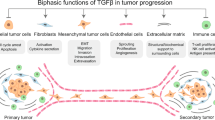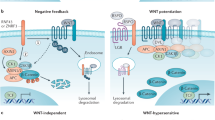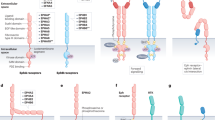Key Points
-
The hedgehog (Hh) signalling pathway is a key regulator of embryonic development, and its deregulation is associated with various birth defects.
-
Although mostly quiescent in adult tissues, Hh signalling has recently been recognized to participate in tissue repair and tumour growth.
-
Basal cell carcinoma and medulloblastoma, two cancers that involve mutation-driven upregulation of Hh signalling, were the first cancers shown to involve the Hh pathway.
-
Numerous other solid tumours, including pancreatic and prostate cancers, are now thought to have hyper-activated Hh signalling. In these cases, the signalling is stimulated by excessive production of Hh ligands by tumour cells.
-
Several families of small-molecule Hh inhibitors have been identified and are in varying stages of clinical development.
-
The pleiotropic nature of the Hh pathway, seen to be involved in tumour-cell and tumour stem-cell proliferation, as well as in angiogenesis, suggests that Hh antagonists might constitute, under some circumstances, an exciting new type of cancer treatment.
Abstract
Several key signalling pathways, such as Hedgehog, Notch, Wnt and BMP–TGFβ–Activin (bone morphogenetic protein–transforming growth factor-β–Activin), are involved in most processes essential to the proper development of an embryo. It is also becoming increasingly clear that these pathways can have a crucial role in tumorigenesis when reactivated in adult tissues through sporadic mutations or other mechanisms. We will focus here on the Hedgehog pathway, which is abnormally activated in most basal cell carcinomas, and discuss potential therapeutic opportunities offered by the progress made in understanding this signalling pathway.
This is a preview of subscription content, access via your institution
Access options
Subscribe to this journal
Receive 12 print issues and online access
$209.00 per year
only $17.42 per issue
Buy this article
- Purchase on Springer Link
- Instant access to full article PDF
Prices may be subject to local taxes which are calculated during checkout



Similar content being viewed by others
References
Ingham, P. W. & McMahon, A. P. Hedgehog signaling in animal development: paradigms and principles. Genes Dev. 15, 3059–3087 (2001).
Roessler, E. et al. Mutations in the human Sonic Hedgehog gene cause holoprosencephaly. Nature Genet. 14, 357–360 (1996).
Weng, A. P. et al. Activating mutations of NOTCH1 in human T cell acute lymphoblastic leukemia. Science 306, 269–271 (2004).
Radtke, F. & Clevers, H. Self-renewal and cancer of the gut: two sides of a coin. Science 307, 1904–1909 (2005).
Nusslein-Volhard, C. & Wieschaus, E. Mutations affecting segment number and polarity in Drosophila. Nature 287, 795–801 (1980).
Kalderon, D. Transducing the hedgehog signal. Cell 103, 371–374 (2000).
Denef, N., Neubuser, D., Perez, L. & Cohen, S. M. Hedgehog induces opposite changes in turnover and subcellular localization of patched and smoothened. Cell 102, 521–531 (2000).
Aza-Blanc, P., Ramirez-Weber, F. A., Laget, M. P., Schwartz, C. & Kornberg, T. B. Proteolysis that is inhibited by hedgehog targets Cubitus interruptus protein to the nucleus and converts it to a repressor. Cell 89, 1043–1053 (1997).
Huangfu, D. & Anderson, K. V. Cilia and Hedgehog responsiveness in the mouse. Proc. Natl Acad. Sci. USA 102, 11325–11330 (2005).
Huangfu, D. et al. Hedgehog signalling in the mouse requires intraflagellar transport proteins. Nature 426, 83–87 (2003).
May, S. R. et al. Loss of the retrograde motor for IFT disrupts localization of Smo to cilia and prevents the expression of both activator and repressor functions of Gli. Dev. Biol. 287, 378–389 (2005).
Corbit, K. C. et al. Vertebrate Smoothened functions at the primary cilium. Nature 437, 1018–1021 (2005).
Ruiz i Altaba, A. Catching a Gli-mpse of Hedgehog. Cell 90, 193–196 (1997).
Duman-Scheel, M., Weng, L., Xin, S. & Du, W. Hedgehog regulates cell growth and proliferation by inducing Cyclin D and Cyclin E. Nature 417, 299–304 (2002).
Pola, R. et al. The morphogen Sonic hedgehog is an indirect angiogenic agent upregulating two families of angiogenic growth factors. Nature Med. 7, 706–711 (2001). An early demonstration that some of the effects of activated Hh signalling in regenerating adult tissue are mediated indirectly via stromal cells.
Machold, R. et al. Sonic hedgehog is required for progenitor cell maintenance in telencephalic stem cell niches. Neuron 39, 937–950 (2003).
Lai, K., Kaspar, B. K., Gage, F. H. & Schaffer, D. V. Sonic hedgehog regulates adult neural progenitor proliferation in vitro and in vivo. Nature Neurosci. 6, 21–27 (2003).
Palma, V. & Ruiz i Altaba, A. Hedgehog-GLI signaling regulates the behavior of cells with stem cell properties in the developing neocortex. Development 131, 337–345 (2004).
Palma, V. et al. Sonic hedgehog controls stem cell behavior in the postnatal and adult brain. Development 132, 335–344 (2005).
van den Brink, G. R. et al. Indian Hedgehog is an antagonist of Wnt signaling in colonic epithelial cell differentiation. Nature Genet. 36, 277–282 (2004).
Mirsky, R., Parmantier, E., McMahon, A. P. & Jessen, K. R. Schwann cell-derived desert hedgehog signals nerve sheath formation. Ann. N. Y. Acad. Sci. 883, 196–202 (1999).
Parmantier, E. et al. Schwann cell-derived Desert hedgehog controls the development of peripheral nerve sheaths. Neuron 23, 713–724 (1999).
Calcutt, N. A. et al. Therapeutic efficacy of sonic hedgehog protein in experimental diabetic neuropathy. J Clin Invest. 111, 507–14 (2003).
Hahn, H. et al. Mutations of the human homolog of Drosophila patched in the nevoid basal cell carcinoma syndrome. Cell 85, 841–851 (1996). This reference (along with references 25–34) established the role of the Hh pathway, previously appreciated as being important in embryonic development, in cancer.
Johnson, R. L. et al. Human homolog of patched, a candidate gene for the basal cell nevus syndrome. Science 272, 1668–1671 (1996).
Dahmane, N., Lee, J., Robins, P., Heller, P. & Ruiz i Altaba, A. Activation of the transcription factor Gli1 and the Sonic hedgehog signalling pathway in skin tumours. Nature 389, 876–881 (1997).
Unden, A. B., Zaphiropoulos, P. G., Bruce, K., Toftgard, R. & Stahle-Backdahl, M. Human patched (PTCH) mRNA is overexpressed consistently in tumor cells of both familial and sporadic basal cell carcinoma. Cancer Res. 57, 2336–2340 (1997). This work and that described in references 38–39 demonstrate the drugability of the Hh pathway and point out the potential therapeutic utility of small-molecule modulators of Hh signalling.
Reifenberger, J. et al. Missense mutations in SMOH in sporadic basal cell carcinomas of the skin and primitive neuroectodermal tumors of the central nervous system. Cancer Res. 58, 1798–1803 (1998).
Xie, J. et al. Activating Smoothened mutations in sporadic basal-cell carcinoma. Nature 391, 90–92 (1998).
Taylor, M. D. et al. Mutations in SUFU predispose to medulloblastoma. Nat. Genet. 31, 306–310 (2002).
Oro, A. E. et al. Basal cell carcinomas in mice overexpressing sonic hedgehog. Science 276, 817–821 (1997).
Nilsson, M. et al. Induction of basal cell carcinomas and trichoepitheliomas in mice overexpressing GLI-1. Proc. Natl Acad. Sci. USA 97, 3438–3443 (2000).
Grachtchouk, M. et al. Basal cell carcinomas in mice overexpressing Gli2 in skin. Nature Genet. 24, 216–217 (2000).
Aszterbaum, M. et al. Ultraviolet and ionizing radiation enhance the growth of BCCs and trichoblastomas in patched heterozygous knockout mice. Nature Med. 5, 1285–1291 (1999).
Svard, J. et al. Genetic elimination of Suppressor of fused reveals an essential repressor function in the mammalian Hedgehog signaling pathway. Dev. Cell 10, 187–197 (2006).
Dellovade, T., Romer, J. T., Curran, T. & Rubin, L. L. The hedgehog pathway and neurological disorders. Annu. Rev. Neurosci. 29, 539–563 (2006).
Frank-Kamenetsky, M. et al. Small-molecule modulators of Hedgehog signaling: identification and characterization of Smoothened agonists and antagonists. J. Biol. 1, 10 (2002).
Williams, J. A. et al. Identification of a small molecule inhibitor of the hedgehog signaling pathway: effects on basal cell carcinoma-like lesions. Proc. Natl Acad. Sci. USA 100, 4616–4621 (2003).
Chen, J. K., Taipale, J., Young, K. E., Maiti, T. & Beachy, P. A. Small molecule modulation of Smoothened activity. Proc. Natl Acad. Sci. USA 99, 14071–14076 (2002).
Athar, M. et al. Inhibition of smoothened signaling prevents ultraviolet B-induced basal cell carcinomas through regulation of Fas expression and apoptosis. Cancer Res. 64, 7545–7552 (2004).
Flagella, K. et al. Effects of a topical Hedgehog antagonist on normal skin. Toxicologist 90, S1 (2006).
Fretzin, S., Dawes, K., Rundle, A. & Caro, I. Safety of a topically applied novel small molecule inhibitor of the Hedgehog signaling pathway in subjects with basal cell carcinoma. Australas. J. Dermatol. 47 (Suppl. 1), A59 (2006).
Tas, S. & Avci, O. Induction of the differentiation and apoptosis of tumor cells in vivo with efficiency and selectivity. Eur. J. Dermatol. 14, 96–102 (2004).
Wallace, V. Purkinje-cell-derived Sonic hedgehog regulates granule neuron precursor cell proliferation in the developing mouse cerebellum. Curr. Biol. 9, 445–448 (1999).
Wechsler-Reya, R. J. & Scott, M. P. Control of neuronal precursor proliferation in the cerebellum by Sonic Hedgehog. Neuron 22, 103–114 (1999).
Dahmane, N. & Ruiz-i-Altaba, A. Sonic hedgehog regulates the growth and patterning of the cerebellum. Development 126, 3089–3100 (1999).
Dahmane, N. et al. The Sonic Hedgehog-Gli pathway regulates dorsal brain growth and tumorigenesis. Development 128, 5201–5212 (2001).
Berman, C. M. et al. Medulloblastoma growth inhibition by hegehog pathway blockade. Science 297, 1559–1561 (2002).
Romer, J. T. et al. Suppression of the Shh pathway using a small molecule inhibitor eliminates medulloblastoma in Ptc 1+/−p53−/− mice. Cancer Cell 6, 229–240 (2004). A clear illustration that an oral Hh antagonist can significantly inhibit the growth of medulloblastoma in mice.
Sanchez, P. & Ruiz i Altaba, A. In vivo inhibition of endogenous brain tumors through systemic interference of Hedgehog signaling in mice. Mech. Dev. 122, 223–230 (2005).
Sasai, K. et al. Shh pathway activity is down-regulated in cultured medulloblastoma cells: implications for preclinical studies. Cancer Res. 66, 4215–4222 (2006).
Bellusci, S. et al. Involvement of Sonic hedgehog (Shh) in mouse embryonic lung growth and morphogenesis. Development 124, 53–63 (1997).
Pepicelli, C. V., Lewis, P. M. & McMahon, A. P. Sonic hedgehog regulates branching morphogenesis in the mammalian lung. Curr. Biol. 8, 1083–1086 (1998).
Chung, U., Schipani, E., McMahon, A. P. & Kronenberg, H. Indian hedgehog couples chondrogenesis to osteogenesis in endochondrial bone development. J. Clin. Invest. 107, 295–304 (2001).
St-Jacques, B., Hammerschmidt, M. & McMahon, A. P. Indian hedgehog signaling regulates proliferation and differentiation of chondrocytes and is essential for bone formation. Genes Dev. 13, 2072–2086 (1999).
Hebrok, M., Kim, S. K., St-Jacques, B., McMahon, A. P. & Melton, D. A. Regulation of pancreas development by hedgehog signaling. Development 127, 4905–4913 (2000).
Tiet, T. D. & Alman, B. A. Development pathways in musculoskeletal neoplasia: involvement of the Indian Hedgehog-parathyroid hormone-related protein pathway. Pediatr. Res. 53, 539–543 (2003).
Tiet, T. D. et al. Constitutive hedgehog signaling in chondrosarcoma up-regulates turmor cell proliferation. Am. J. Pathol. 168, 321–330 (2006).
Watkins, D. N. et al. Hedgehog signalling within airway epithelial progenitors and in small-cell lung cancer. Nature 422, 313–317 (2003). An important description of Hh ligand over-production by tumours cells accelerating tumour-cell growth.
Thayer, S. P. et al. Hedgehog is an early and late mediator of pancreatic cancer tumorigenesis. Nature 425, 851–856 (2003).
Berman, D. M. et al. Widespread requirement for Hedgehog ligand stimulation in growtht of digestive tract tumours. Nature 425, 846–851 (2003).
Karhadkar, S. S. et al. Hedgheog signalling in prostate regeneration, neoplasia and metastasis. Nature 431, 707–712 (2004).
Sanchez, P. et al. Inhibition of prostate cancer proliferation by interference with SONIC HEDGEHOG-GLI1 signaling. Proc. Natl Acad. Sci. USA 101, 12561–12566 (2004).
Sheng, T. et al. Activation of the Hedgehog pathway in advanced prostate cancer. Mol. Cancer 3, 29 (2004).
Fan, L. et al. Hedgehog signaling promotes prostate xenograft tumor growth. Endocrinology 145, 3961–3970 (2004).
Al-Hajj, M. & Clarke, M. F. Self-renewal and solid tumor stem cells. Onocogene 23, 7274–7282 (2004).
Liu, B. Y., McDermott, S. P., Khwaja, S. S. & Alexander, C. M. The transforming activity of Wnt effectors correlates with their ability to induce the accumulation of mammary progenitor cells. Proc. Natl. Acad. Sci. USA 101, 4158–4163 (2004).
Liu, S. et al. Hedgehog signaling and Bmi-1 regulate self-renewal of normal and malignant human mammary stem cells. Cancer Res. 66, 6063–6071 (2006). This paper implicated the Hh pathway in the proliferation of stem cells in solid tumours.
Liu, S. Dontu, G. & Wicha, M. S. Mammary stem cells, self-renewal pathways, and carcinogenesis. Breast Cancer Res. 7, 86–95 (2005).
Dontu, G. et al. Role of Notch signaling in cell-fate determination of human mammary stem/progenitor cells. Breast Cancer Res. 6, R605–R615 (2004).
Beachy, P. A., Karhadkar, S. S. & Berman, D. M. Tissue repair and stem cell renewal in carcinogenesis. Nature 432, 324–331 (2004).
Tenzen, T., Allen, B. L., Cole, F., Kang, J. S., Krauss, R. S. & McMahon, A. P. The cell surface membrane proteins cdo and boc are components and targets of the hedgehog signaling pathway and feedback network in mice. Dev Cell 10, 647–656 (2006).
Yao, S., Lum, L. & Beachy, P. The ihog cell-surface proteins bind hedgehog and mediate pathway activation. Cell 125, 343–357 (2006).
Zhang, W., Kang, J. S., Cole, F., Yi, M. J. & Krauss, R. S. Cdo functions at multiple points in the sonic hedgehog pathway, and cdo-deficient mice accurately model human holoprosencephaly. Dev. Cell 10, 657–665 (2006).
Huangfu, D. & Anderson, K. V. Signaling from Smo to Ci/Gli: conservation and divergence of Hedgehog pathways from Drosophila to vertebrates. Development 133, 3–14 (2006).
Xie, J. et al. Mutations of the PATCHED gene in several types of sporadic extracutaneous tumors. Cancer Res. 57, 2369–2372 (1997).
Raffel, C. et al. Sporadic medulloblastomas contain PTCH mutations. Cancer Res. 57, 842–5 (1997).
Taylor, M. D. et al. Mutations in SUFU predispose to medulloblastoma. Nature Genet. 31, 306–310 (2002).
Tostar, U. et al. Deregulation of the hedgehog signalling pathway: a possible role for the PTCH and SUFU genes in human rhabdomyoma and rhabdomyosarcoma development. J. Pathol. 208, 17–25 (2006).
Kubo, M. et al. Hedgehog signaling pathway is a new therapeutic target for patients with breast cancer. Cancer Res. 64, 6071–6074 (2004).
Qualtrough, D., Buda, A., Gaffield, W., Williams, A. C. & Paraskeva, C. Hedgehog signalling in colorectal tumour cells: induction of apoptosis with cyclopamine treatment. Int. J. Cancer 110, 831–837 (2004).
Oniscu, A. et al. Expression of Sonic hedgehog pathway genes is altered in colonic neoplasia. J. Pathol. 203, 909–917 (2004).
Monzo, M. et al. Sonic hedgehog mRNA expression by real-time quantitative PCR in normal and tumor tissues from colorectal cancer patients. Cancer Lett. 233, 117–123 (2006).
Huang, S. et al. Activation of the hedgehog pathway in human hepatocellular carcinomas. Carcinogenesis 27, 1334–1340 (2006).
Taipale, J. et al. Effects of oncogenic mutations in Smoothened and Patched can be reversed by cyclopamine. Nature 406, 1005–1009 (2000).
Borzillo, G. V. & Lippa, B. The Hedgehog signaling pathway as a target for anticancer drug discovery. Curr. Top. Med. Chem. 5, 147–157 (2005).
The Genomics Institute of the Novartis Research Foundation. Compounds and compositions as Hedgehog pathway modulators. World Patent WO 2006050351 (2006).
Acknowledgements
The authors would like to thank their many colleagues at Curis and Genentech who have participated so actively in the Hedgehog antagonist program. We would like to thank K. Kotkow for helpful suggestions, J. LaLonde for editorial assistance, D. Wood and M. Dina for help with artwork and figures.
Author information
Authors and Affiliations
Corresponding author
Ethics declarations
Competing interests
L.L.R. is a consultant for and shareholder in Curis, Inc. F.S. is an employee of and shareholder in Genetech.
Related links
Glossary
- Holoprosencephaly
-
A birth defect that can result as a consequence of insufficient Hh signalling. It relates to a failure of the brain to properly separate into two halves and in its extreme form can be associated with cyclopia, the presence of a single centrally located eye.
- Mitogen
-
Any molecule that stimulates the division of a cell.
- Allograft
-
As used here, a mouse cancer model in which a tumour is removed from one mouse — in which it has occurred spontaneously, for example — and implanted into another mouse or into several mice in order to test the efficacy of an antitumour drug.
- Xenograft
-
A graft of tissue or cells transplanted between animals of different species.
- Autocrine, juxtacrine and paracrine signalling
-
Three modes of signalling in which a molecule produced by one cell can activate signalling in the same cell (autocrine), a neighbouring cell (juxtacrine) or a cell at a distance (paracrine).
- Gleason grade
-
A scoring system for prostate cancers that reflects the degree of disease progression. A score of 1 indicates mild cancer and a score of 5 indicates advanced cancer.
- Epithelial—mesenchymal transition
-
A morphological change in cells such that they lose their epithelial or adhesive organized phenotype and become more motile, sometimes as the beginning of the metastatic process.
- Cancer stem cell
-
A slowly proliferating stem-like cell thought to be present in small numbers in solid tumours, to be resistant to standard chemotherapy and to have an enhanced capacity to give rise to new tumours.
Rights and permissions
About this article
Cite this article
Rubin, L., de Sauvage, F. Targeting the Hedgehog pathway in cancer. Nat Rev Drug Discov 5, 1026–1033 (2006). https://doi.org/10.1038/nrd2086
Issue Date:
DOI: https://doi.org/10.1038/nrd2086
This article is cited by
-
Synthesis and molecular docking simulations of novel azepines based on quinazolinone moiety as prospective antimicrobial and antitumor hedgehog signaling inhibitors
Scientific Reports (2024)
-
GREB1L overexpression is associated with good clinical outcomes in breast cancer
European Journal of Medical Research (2023)
-
Targeted protein degradation reveals BET bromodomains as the cellular target of Hedgehog pathway inhibitor-1
Nature Communications (2023)
-
The ULK3 kinase is a determinant of keratinocyte self-renewal and tumorigenesis targeting the arginine methylome
Nature Communications (2023)
-
Involvement of redox signalling in tumour cell dormancy and metastasis
Cancer and Metastasis Reviews (2023)



